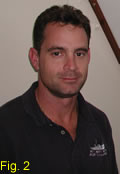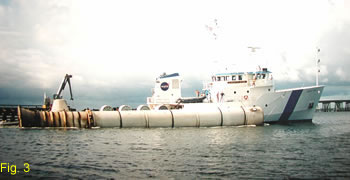May 2, 03
The Lustrous Liberty Star
As you might imagine, a 176-foot, 1,052-ton ship requires some attention.
The 10 men who comprise the crew of the NASA-owned M/V Liberty Star,
(figure 1) home to this eight-day Oculina expedition, on the other hand require very little. They simply go
about their business. But while these guys won’t make any
headlines, you’d best believe their presence is well acknowledged
and most-highly appreciated by all aboard, totally dependant on
their collective expertise.
expedition, on the other hand require very little. They simply go
about their business. But while these guys won’t make any
headlines, you’d best believe their presence is well acknowledged
and most-highly appreciated by all aboard, totally dependant on
their collective expertise.
To suggest the men of the Liberty Star crew go about their business
“simply” is not to suggest they do so quietly. That
would be a misperception. No; they make some noise, good-natured
noise, contributing to an inclusive ad hoc culture.
Captain Bren Wade (figure 2) oversees
a crew that includes a marine specialist, second mate, boatswain,
engineers, divers, able-bodied seamen, a crane operator and a cook
(anyone among the research team who doesn’t return from this
voyage  having
not gained at least a pound or two, frankly just isn’t cooperating:
Rolando is treating us right).
having
not gained at least a pound or two, frankly just isn’t cooperating:
Rolando is treating us right).
These men have arrived onboard the Liberty Star from hometowns throughout
the country, from vastly varied backgrounds and myriad motivations.
They hold in common a kinship with the sea. They’re drawn
to the uniqueness of the lifestyle it affords and the challenges
it presents.
“These are some great guys,” says Wade, and the science
team seconds the sentiment.
Wade comes by the love of his work genetically: his granddad worked
on the NASA Gemini project. He’s a native of Cocoa Beach,
Fla., earned a BS in marine transportation from the U.S. Merchant
Marine Academy and also holds an MBA from Webster University. He
worked on tugboats in Seattle and Alaska for three years, then returned
to his native Florida “to find work on a ship.” He’s
been onboard the Liberty Star for 10 years, about a year now as
captain.
The primary function of the Liberty Star is to recover the solid
rocket boosters (SRBs) shed by space shuttles just after launch,
and return them to the Kennedy Space Center for refurbishment. An
SRB fully loaded with propellant weighs about 1.4 million pounds,
stands 149.2 feet tall and is 12 feet in diameter. A shuttle is
outfitted with two SRBs, which propel it to a speed of 3,512 miles
per hour. Approximately two minutes after liftoff, the SRBs have
expended their fuel, separate from the shuttle and, some five minutes
later, drop into the Atlantic Ocean. Divers from the Liberty Star
and another recovery vessel enter the water and connect one booster
to each ship’s towline; they’re then towed back to Cape
Canaveral Air Station (figure 3).
The Liberty Star was built at the Atlantic Marine Shipyard on Fort
George Island, Fla., in 1981. The ship is 176 feet in length, 37
feet in width and draws about 12 feet of water. It’s propelled
by two main engines providing a total of 2,900 horsepower. It’s
capable of towing 60,000 pounds. The main engines turn two seven-foot
propellers with controllable pitch, which provides greater response
time and maneuverability. The ship is also equipped with two thrusters.
The stern thruster is a water-jet system that allows the ship to
move in any direction without the use of propellers, a system installed
to protect the endangered manatee population that inhabits regions
of the Banana River where the Liberty Star is based. This system
also allows divers to more safely work near the ship during operations.
The ship also is equipped with state-of-the-art Global Positioning
System (GPS) navigation equipment.
In 1998 the Liberty Star began to take on new missions on NASA’s
behalf. It now tows Space Shuttle external tanks from New Orleans
– quite a nice port-o-call, if you ask the Liberty Star gang
– to Florida. It supports side-scan sonar operations, cable-laying,
underwater search and salvage, drone aircraft recovery, serves as
a platform for robotic submarine operations, and this week is hosting
the Oculina expedition.
Bottom line: The Liberty Star and its crew are earning their keep,
and then some – and apparently having a big time doing it.







